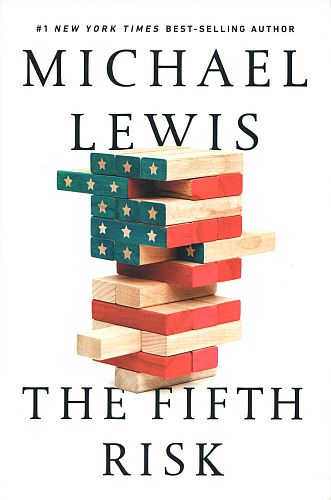

| THE FIFTH RISK Michael Lewis New York: W. W. Norton & Company, October 2018 |
Rating: 5.0 High |
|||
| ISBN-13 978-1-324-00264-2 | ||||
| ISBN-10 1-324-00264-6 | 219pp. | HC | $26.95 | |
The strength of this book is that it focuses on individuals, probing their specific circumstances and letting their words and their track records vouch for them. For example, it introduces us to Max Stier, the man dedicated to making the U.S. government a place where talented young people would want to work.1
"Max soon realized that to attract talented young people to government service he'd need to turn the government into a place talented young people wanted to work. He'd need to fix the United States government. Partnership for Public Service, as Max called his organization, was not nearly as dull as its name. It trained civil servants to be business managers; it brokered new relationships across the federal government; it surveyed the federal workforce to identify specific management failures and success (sic); and it lobbied Congress to fix deep structural problems. It was Max Stier who had persuaded Congress to pass the laws that made it so annoyingly difficult for Donald Trump to avoid preparing to be president." – Page 23 |
The people we meet in these pages are, like Max, generally not household names. They were selected because they are, in the author's term, mission-driven people. They include Ali Zaidi, Kevin Concannon, Cathie Woteki, Lillian Salerno, and Kathy Sullivan.2 Other qualities they have in common are intelligence, ability, and dedication. Also, they share histories of career success. All of this matters because, as John MacWilliams informs the author in a discussion of risks facing the nation in the Trump era, project management — or mismanagement — is the fifth risk.
In each case, Lewis takes us through a summary of their career, letting us see their main accomplishments and hear their philosophy of government.
Donald John Trump and sundry members of his transition team also appear. But they are the other side of the coin: the money-driven people. In addition to greed, the traits they have in common are: the inability to handle complex subjects, or to think in the long term; loyalty to individuals rather than to organizations or laws; a preference for transactional deals — the quid pro quo — as opposed to rules and procedures.
It's surely well known by now that Trump didn't want a transition team, and railed against it when he found out it was required by law. This book reports the conversation in vividly verbatim terms; Bob Woodward's book Fear does the same. Trump simply has no conception of the laws and conventions that govern American politics, and no interest in learning about them.
The Trump transition effort was late and lax to a degree never before seen in the modern era. and it was noteworthy for selecting people antithetical to the goals of the agencies they were nominated to join. The upside to this perversity is that, being Trump selections, they were typically long on loyalty and short on ability.
Trump's picks for cabinet members and other high-level posts follow a similar pattern. There is Rick Perry at DOE, heading one of the departments he vowed to shut down. There is Ryan Zinke at Interior: a dedicated resource extractor and Sagebrush Rebellion adherent. Betsy DeVos at Education, striving to turn public, secular schools into private, Christian ones. Ben Carson at Housing and Urban Development: a former neurosurgeon with no housing experience. And at the EPA we had Scott Pruitt, a deregulator too dramatically corrupt even for Trump — now replaced by the smoother Andrew Wheeler. Indeed, it is easier to list the appointees who are both competent and supportive of their department's mission. And more positions have gone unfilled than ever before.
The position Trump took longest to fill was that of presidential science adviser. He finally nominated meteorologist Kelvin Droegemeier in August of this year. Ironically for such a science-averse crew, this nominee has not been confirmed. I can only conclude it is because he is well respected by the scientific community.
Who are the people Team Trump nominated to head the transition efforts at various agencies? A few of them are:
DJ Patil, who wrote a number of memos for the transition team to explain what a treasure trove of data existed at NOAA and other agencies, wondered for some time why they paid no attention — why they preferred in fact to hide so much data from the public.
"Then he realized: The man Trump had nominated to run NOAA thought that people who wanted a weather forecast should have to pay him for it. There was a rift in American life that was now coursing through American government. It wasn't between Democrats and Republicans. It was between the people who were in it for the mission, and the people who were in it for the money." – Pages 190-191 |
This book has one defect: it lacks an Index. I won't mark it down for that, because it does its job so well; its narratives of individual civil servants succeeding at their various missions lay bare the stark contrast between their lives and the lives of the Trumpeteers brought in to supervise or replace them. In this way it nicely complements the more detail-rich but drier accounts of the Trump era like Russian Roulette. I won't be keeping my copy, but I do consider it a must-read.

 To contact Chris Winter, send email to this address.
To contact Chris Winter, send email to this address.